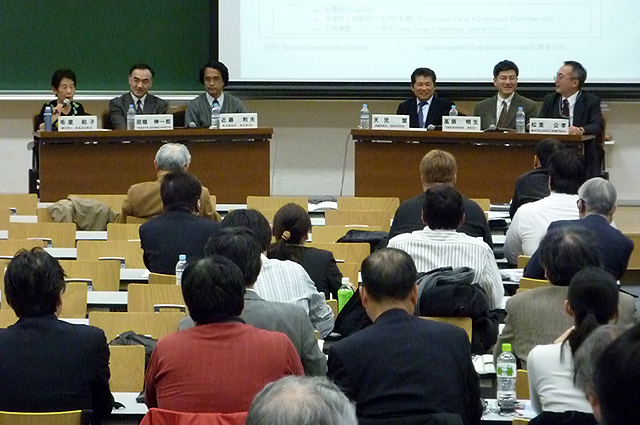|
The SRC international symposium
“Comparing the Politics of the Eurasian Regional Powers:
China, Russia, India and Turkey”
was held on December
12-13,
2009
January
14, 2010, by TANG
Liang
The Second International Symposium of Comparative Research on Major
Regional Powers in Eurasia was held at the Sotobori Building at the
Ichigaya Campus of Hosei University on Dec. 12-13, 2009. This symposium
was mainly organized by the Domestic Politics Group (Group 2). The
symposium considered the dynamics of political change, the realities of
economic transition and issues of local governance as well as
methodologies in comparative politics of regional powers in the context
of phenomena such as globalization, liberalization and development in
information technology, under the general theme “Comparing the Politics
of the Eurasian Regional Powers: China, Russia, India and Turkey.” The
event consisted of a panel discussion composed of keynote speeches and
a round table, and three other sessions.
The 3 speakers that delivered the keynote speeches
analyzed the political and economic transition as well as the impact of
the development of the Indian economy on development economics, within
the framework of the comparative perspective of each regional power
based on the experiences of the former Soviet and Russia, China and
India. The panelists at the roundtable discussed the greater aim of
comparative research and methods of conducting comparative research as
well as the methodological and practical issues that may arise in the
joint efforts or collaboration among area studies scholars of various
fields or disciplines. The roundtable ended with the recognition of the
importance of the intellectual process to conduct comparative analysis
to not only to extract each country’s unique characteristics but also
to generalise common issues.
The presentations during the first session,
“Sub-national Units for Modernization and Democracy: Villages and NGOs
in Russia, China, and India,” included a comparative analysis between
India and Russia concerning the relationship between sub-national
democracy and the influence of Christianity, comparative study on the
governance and public goods in Chinese and Russian villages and a
comparative analysis of social conflict and conflict resolution using
the case of land expropriation issue in China and India. Much of the
focus of the audience was on the achievements based on rich statistical
data, field work and case studies.
There is nothing more political than religion.
Religious politics is a crucial touchstone for the future of regional
powers as we are witness to the Xinjiang issue in China, Chechnya issue
in Russia, religious conflict between the Hindu and other religions and
the heightening of Islamism in Turkey. The presentations in the 2nd
session “A Key to Greatness. Religious Politics in Regional Powers”
consisted of the influence of the religious and cultural difference--
particularly Christianity and the distinctiveness of Asian values--on
human rights, the management of Islamic mosques and organizations in
Turkey, Russia and China, and a comparative analyasis on ethnic and
religious conflicts and foreign policies in South Asia.
Economic development has progressed in regional
powers and the quality of life of the people has improved to some
extent, however, the distribution of the benefits of development is not
always equal. In the 3rd session “Realignment of Social Strata and its
Cleavages” The first speaker, Vamsi Vakulabharanam, identified the
similarity and difference between India and China regarding the
economic inequality using statistical data. The second speaker, Hiroaki
Hayashi, analyzed the composition of the Russian middle class and the
diversity of values and compared it to the middle class in China. The
last speaker, Shigeto Sonoda, presented his comparative analysis on how
social inequality is perceived in China, India and Russia, based on the
survey data of the Asia Barometer 2008.
The underlying perspective throughout the
symposium was a challenging and dynamic attempt for “comparison.” We
were able to not only illustrate the particularities of each regional
power, but also move towards the direction of abstracting common or
universal qualities. Moreover, the two day symposium brought in an
audience of 150 and vigorous and lively discussions took place between
the speakers and participants. The Nihon Keizai Shimbun and Hokkaido
Shimbun both reported on this event on their paper issued on Dec 13th.
The famous Chinese news site, Xinhua, also uploaded an article
regarding this symposium. The presentations and the roundtable
discussion will be published as discussion papers of the Comparative
Research on Major Regional Powers in Eurasia Project. The valuable
knowledge and information obtained from this symposium will certainly
be significant asset to the project in the future.

[index]
|

